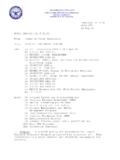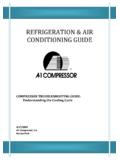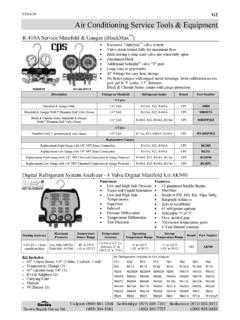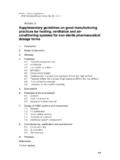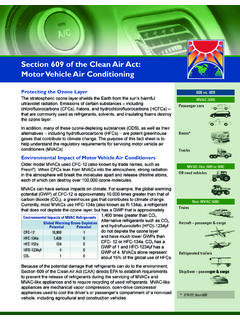Transcription of U.S. Navy
1 NavyPre-Entry Physical Training PlanNavy Environmental Health CenterNaval Aviation Schools CommandD. M. Settles & Brown Fit Today for Tomorrow s Challenges Introduction:The Navy Pre-Entry Physical Training Plan assists recruits in preparing for the physical demands a prospective Sailor experiences during Navy basic training programs. This plan provides guidelines for the three primary elements of a physical fitness program: aerobic activity, muscular strength and endurance exercises, and flexibility exercises. Research supports that participation in these activities will decrease one s injury risk during Navy basic training programs; the Navy Pre-Entry Physical Training Plan will prepare the prospective Sailor for the physical challenges of basic training and throughout one s Navy Fitness Overview:Physical fitness is an essential and critical component of readiness.
2 Fitness is much more than the absence of disease. It is a state of being that includes strong, flexible muscles and an efficient system for getting oxygen and nutrientsto the body. Physical fitness is a state of being that must be maintained. You have to specifically exercise the muscles and joints where you want improvement. It is also achievable by everyone, despite body type, family health history, and past habits. A physical activity program includes 3 primary components:Aerobic (Cardiovascular):Aerobicactivities, such as running and swimming, help the heart, lungs and blood vessels become more effective atdelivering to the muscles what they need to function -oxygen and glucose. Muscular Strength and Endurance:These activities include exercises such as push-ups, curl-ups, or weight training.
3 Muscular strength and endurance activities help your muscles become stronger, giving them both the raw strength and ability to work repeatedly without undue fatigue. Flexibility:Flexibility or stretching exercises are necessary to prevent injury to the muscles and joints, and to allow the muscles to work efficientlythrough a full range of NavyPre-Entry Physical Training Plan1 Warm-UpA warm-up prior to exercise is recommended to prepare the muscles and heart for the workout. Participation in a 3 to 5 minute warm-up during the first portion of your exercise session will assist you in decreasing your chances of getting injured. Examples of warm-up exercises include walking, slow jogging, or any nonvigorous, low intensity activity. StretchingPage 3 will outline a safe and effective stretching program foryour body s major muscle groups.
4 Stretching exercises should be conducted after the warm-up and cool-down exercise Activity SessionPages 4 and 5 will outline guidelines for preparing for aerobicdemands that you will incur during basic training. Page 6 and 7 will assist you in preparing for the the muscular exercise demands that you will experience during basic training. Cool-Down:A cool-down consists of 3 to 5 minutes of light to moderate slow activity after vigorous exercise. Stopping exercise abruptly can result in lightheadedness and cancause excessive stress on your Exercise SequenceRecommended Exercise Sequence:Diagram 1outlines the recommended exercise sequence to improve performance and to reduce risk of injury; this exercise sequence should be conducted between 3 to 6 days per week. If you feel any unusual pain or discomfort during your physical activity session or if you answer yes to any questions listed in the Physical Readiness Questionnaire (Appendix 2), contact your allied health professional prior to beginning an exercise program.
5 There is some risk of injury associated with physical activity. To prevent injury, remember to pace yourself, especially if you have not participated regularly in an exercise program. * Review the injury prevention section of this booklet prior to beginning a personal exercise program (pp. 11 -13).(1) Warm-Up(2) Stretching(3) Physical Activity Session (Aerobic, Muscular Strength and Endurance Exercise, Sporting Event)(4) Cool Down(5) StretchingDiagram 12 Stretching/Injury PreventionAfter your warm-up, you should always begin with a period of stretching. Stretching makes the muscles, ligaments, and tendons more flexible and elastic-like. Rather than tearing or breaking when under strain, a flexible muscle is more likely to stretch and give. Flexibility prevents injuries, like back injuries and sprained ankles, and helps you perform everyday task with greater ease.
6 Stretching is joint specific -you have to target each muscle group and joint separately. Diagram 2provides 10 stretches to include in your daily exercise program; these stretches will improve the flexibility of your body s major muscle groups. It is importantto also include stretching exercises during the cool-down portion of your exercise and Effective Stretching Guidelines:* Stretch at least 5 times a week (every day is better) * Stretch to a point of mild tension * Warm-up 3 to 5 minutes before stretching * Hold eachstretch for 10 to 30 sec.* Prevent bouncing movement when stretching * Repeat each stretch 3 to 5 timesDiagram 2 PRT Flexibility Test:Although no flexibility test measures the flexibility of all joints, the sit and reach test serves as an important functional measure of hip and back flexibility.
7 To perform the sit and reach test, sit with legs straight, feet together, with shoes off and toes pointed up. Slowly reach forward and attempt to touch the tips of the toes with fingertips of both hands. Hold the reach for one second; DO NOT BOUNCE OR LUNGE. The Navy PRT Score Categories for the sit and reach test are included in Appendix 1. * The sit and reach exercise should only be used for testing purposes; it should NOT be included in your daily exercise program due to the excessive stress the stretch places on the low back. The Hamstring Stretch shownin Diagram 2is a safe and effective stretch for the hamstring muscle one physical fitness component that stands out in virtually all studies for the prevention of injuries is aerobic fitness. Studies show that being aerobically conditioned prior to entering basic training will greatly decrease your chances of getting injured.
8 The lower the initial level of fitness when starting basic training, the greater the risk of experiencing a training related injury. Though running is a primary component of basic training exercise sessions, you may choose to participate in a wide variety of aerobic activities prior to beginning basic training. Other types of aerobic activity include, but are not limited to, the following exercises: cycling, swimming, aerobics classes, hiking, rowing, Program:Running will be one of the more strenuous tasks you will performduring basic training programs. The following regimen should help you best prepare for the rigorous demands of basic training. Use the program as follows:Locate the run stage placement chart (Diagram 3). On the left side locate where you fall on the total miles you have run over the last 4 weeks.
9 Then move to the running program chart (Diagram 4). Enter at your starting stage level. Now follow the distance, time goal and frequency as noted. If you are an experienced runner, start at the stage and distance you normally run and progress from there. TheNavy PRT Score Categories for Running are included in Appendix 1. You will be expected to score a good score for your age group during enlisted basic training and Officer Indoctrination School (OIC), between a good and excellent score at the NavalAcademy, and an excellent score at Officer Candidate School (OCS).(Diagram 3)Run Stage Placement ChartTotal Miles Run DuringThe Last 4 MilesMile RunTime1 MileFemaleRun TimeStartingStageLess than - - - - - - - - - +104 Stage / WeekActivityDistanceMilesTime Goal(minutes)Times PerWeek1 Walk23232 Walk34833 Run 2 3 5 times2534 Run 3 2 5 Times2535 Run 4 1 5 Times253 Male Female6 Run222 2437 Run220 2238 Run2 25 2739 Run2 23 25310 Run330 33311 Run327 30312 Run324 27313 Run324 27314 Run324 27315 Run324 27316 Run323 26317 Run323 26318 Run322 25319 Run322 25320 Run321 24321 Run321 24322 Run3 25 28323 Run3 24 27324 Run428 323 Basic Training Pre -Entry Running Program(Diagram 4)
10 5 Curl-UpsAbdominal curl-ups are an indicator of abdominal muscle group endurance which has been identified as an important predictor in low back injury. This exercise, along with running and push-ups, will be tested many times throughout your career in the and Effective Abdominal Curl-Ups:Abdominal curl-ups are an important component of your pre-entry training program. Curl-ups are the best exercise for strengthening the abdominal muscles. Curl-ups must be done with the knees flexed to 90 degrees to eliminate the curve in the low back. The abdominal muscles should be contracted. The head should be lifted off the floor, and the trunk should curl into the sit-up position. Alteration of this technique may cause additional strain to the low back. It is necessary only to do a partial curl-up to provide maximal benefit to the abdominal muscles.
